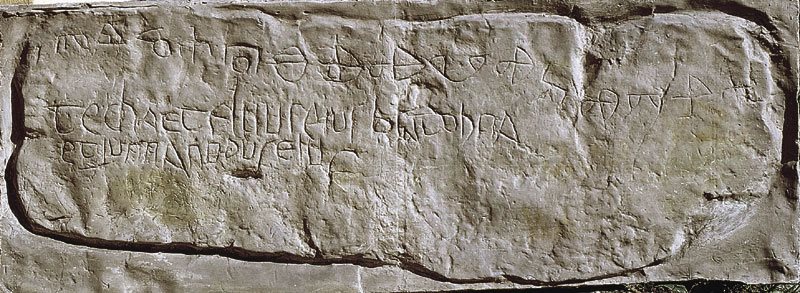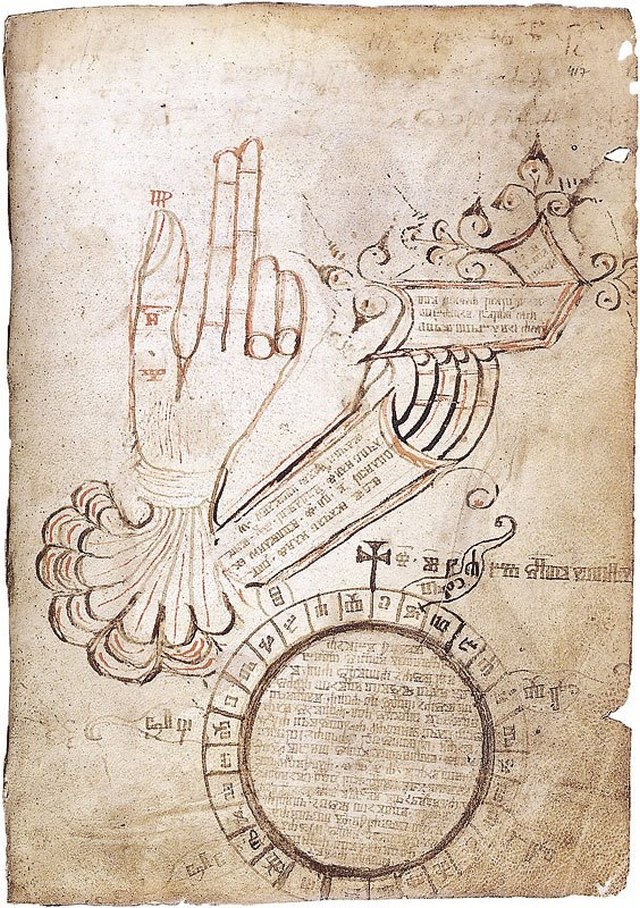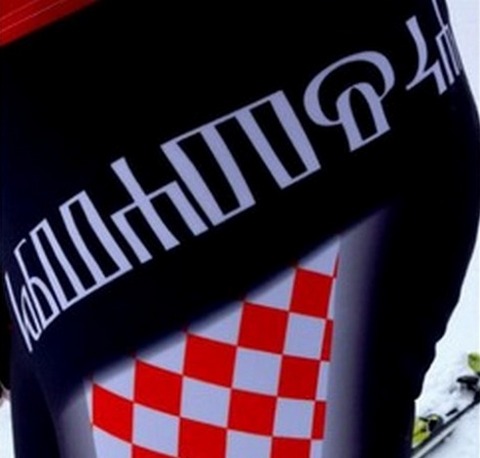|
Croatian Glagolitic books and manuscripts are kept, except in Croatia, in as many as 27 countries
Video by Filip Cvitić, Epistula Croatica, Zagreb  | A famous Reims Evangel, written in Croatian Glagolitic Script in the Prague in 1395, is kept in France in the city of Reims. The Croatian Glagolitic part of this book is a result of activities of Croatian glagolitic priests in the Prague from 1348 onward in the benedictine convent of Emaus, built for them by the Czech King Charles IV. The Cyrillic part of the Evangel is even older, from 11th century, from Kiev, Ukraine. According to a legend in France, the French Kings were sworn in with the book during the coronation in the Reims Cathedral, among them Louis XIV. | Croatian Glagolitic books and manuscripts are kept, except in Croatia, in 27 countries, mostly in Western Europe. |
THE CROATIAN GLAGOLITIC SCRIPT
Recollection of a Medieval European Script
Exhibition: 13 December 2012 - 24 February 2013
Palais du Tau
2, place du Cardinal Luçon
51100 Reims
9:30 - 12:30 and 14:00 - 17:30
closed on Mondays
Booklet of the exhibition in Reims [ PDF] |  We would like to express our special gratitude to the Bibliotheque of Reims, for having published high quality photos of the Reims Evangel via Internet. May we ask Bibliotheque Nationale, Paris, to publish some of important Croatian Glagolitic books via Internet as well? For example, Code slave 11 from 1380, originating from Croatian region of Lika, now kept in this famous library, contains the oldest known nonliturgical verses in Croatian language.        Baska Tablet, carved arround 1100, one of the most important monuments of Croatian written culture. It mentions for the first time the name of "Zvonimir kralj Hrvatski" - "Zvonimir Croatian King", in Croatian language and in Croatian Glagolitic Script. The last page of the first Croatian incunabulum, printed in 1483.
The Croatian Glagolitic Script
The exhibition The Croatian Glagolitic Script — Recollection of a Medieval European Script: from the Middle Ages until the Present Day in the Palace de Tau presents, for the first time in France, some of the most valuable manuscripts, incunabula, missals and monuments written in this script. They also symbolise the thousand years in which Croatia has been a part of European book culture. From the 12th century on, Glagolitic persisted very largely only in the area of Croatian culture, where it developed at first into the angular and then the cursive form known as Croatian Glagolitic. Glagolitic script was retained for a particularly long time on the Adriatic coast, where it was used for writing texts of very diverse purposes (monuments in stone, religious books, poems, legends, registers and so on). Among other works, the exhibition presents the Glagolitic Missal, the oldest European missal printed in a non-Latin script (1483) and the Reims Gospel (1395) upon which the kings of France were wont to swear their coronation oath.
In Croatia the Glagolitic script developed its own angular stylisation. At about the end of the 14th century Glagolitic cursive appeared in all types — literary cursive and chancellery cursive. The basic forms of Croatian angular Glagolitic are based on a few fundamental strokes that are on the whole either horizontal or vertical. The graphy of the letters is extremely symmetrical and enables an abundance of ligatures in combinations of two, three or four letters, a characteristic in which some of its richness and originality inheres. Croatian Glagolitic consists of alphanumeric signs, since each letter also has a numerical value (the numerical value depending on its place in the alphabet or, rather, azbuka). In Croatia the script took the name Glagolitic after the verb (or glagol) glagoljati, to speak, which is often used in gospel writings.
Inscriptions and monuments • Numerous carved inscriptions in Glagolitic are to be found all around Croatia: about a thousand Glagolitic inscriptions and graffiti (small inscriptions scratched in at some later time, mainly on church walls) have been registered. They relate to the building of a church or monastery, to some ecclesiastical inventory, to a building and or the contents of dwelling places, they are carved on stone jars for olive oil and on tombstones. One of the most important of such Glagolitic inscriptions is the Baška Tablet. This is a large stone slab (1x2 m) that was created on the island of Krk in the early 12th century and is important for bearing the very first carved inscription of the people’s own name for themselves in their own language — “Zvonimir Croatian King” — the then king of Croatia and Dalmatia. A cast of this tablet is shown life size in the Palace de Tau.
Manuscripts • The first translations of Biblical texts and of whole books (Psalms, Song of Songs) were written in Glagolitic script, as were many liturgical books, prime sources for Croatian medieval literature, legal monuments (laws, statutes, monastic rules), registers of baptisms, confirmations, weddings and deaths) and other books of a utilitarian nature. The most celebrated Croatian Glagolitic legal text, the Vinodolski zakonik or Vinodol Code (1288), is the oldest legal code in Slavonic languages, apart from a bit older Ruska Pravda of Ukraine. A copy of the 16th century is in existence, and is shown at the exhibition.
The beginnings of printing • The Croats put the Glagolitic script into print in the very oldest period of European printing, in the 15th century, and five incunabula were printed in Glagolitic. The incunabulum the Glagolitic Missal was published on February 22, 1483, in Croatian Church Slavonic, only 28 years after Gutenberg’s Bible. It is the first ever missal in Europe to have been printed in a non-Latin script, and the perfection of the letters, the beauty of the typesetting and printing make it an absolute masterpiece of the printer’s art. This outstanding work is being shown now for the first time in France. Among other exceptional exhibits are the manuscript Breviary of Mavar [Maurus] the Priest (1460), the incunabulum The Baromić Breviary (1493) and the printed Croatian Missal (1531). Although Croatian is written in Latin script today, Glagolitic continued to be printed in Croatia until the beginning of the 20th century (1905). However, Glagolitic still aroused much enthusiasm among the Croats and is one of the strongest determinants of the Croatian cultural identity.
The Croatian Glagolitic script in France • France learned of Glagolitic by the latest in the early 15th century, when George of Slavonia was at work. He was known in medieval sources variously as Georgius de Rayn, Georgius de Sorbonne or Georgius d'Esclavonie and was a Glagolitic priest from the diocese of Aquileia (about 1355-1416). He studied at the Sorbonne, later teaching there. At the end of 1404 he left Paris for Tours, where he was canon and penitentiary of the Cathedral of St Gatien. In Tours he wrote out from memory a Glagolitic primer on the empty pages of a Latin manuscript, kept in the city library in Tours, referring to Glagolitic as alphabeticum chrawaticum (Croatian alphabet). More information.
Glagolitic was recorded in 1538 in the books of the famed Guillaume Postel and in 1573 in the book of Blaise de Vigenčre. In addition, the French National Library in Paris has two important Croatian Glagolitic miscellanies (call numbers Code Slave 11 and Code Slave 73). The Bibliothčque Mazarine in Paris has one of the three copies of the Glagolitic ritual The Édition princeps du Missel glagolitique, 1483 Missel croate, 1531 Postille, 1562 Missel romain Little Book of the Cross, printed in Rijeka in 1531.
And yet Croatian Glagolitic is best known in France because of the Reims Gospel of 1395, a manuscript that once upon a time had costly bindings. The manuscript is composed of two parts of equal format and content, at some later date bound into a single book. The first and smaller part was written in old Cyrillic in the 11th and 12th century, while the second and larger part was written in Emaus Abbey, in fine Croatian upright Glagolitic and Croatian Church Slavonic. It is ornamented with miniatures and initials in lively colours. It contains a selection from the Gospels, the Epistles and the Acts. Cardinal Charles de Lorraine, who acquired the work via Constantinople, solemnly gifted it to the library of Reims Cathedral. The book is also known as Texte du Sacre, referring to several historical sources in which it is mentioned that the kings of France took their coronation oaths on the book. Although it is kept in the Carnegie Library in Reims, it has been loaned for this exhibition.
The exhibition has been devised by Anica Nazor, Fellow of the Croatian Academy of Sciences and Arts and produced by Erasmus naklada d.o.o. Manuscripts, incunabula, missals and original Glagolitic script evangeliaries have been loaned by the National and University Library in Zagreb and the Old Slavonic Institute in Zagreb. The Reims Gospel was lent by the Carnegie Library in Reims. Organised by: Centre for National Monuments — Palace de Tau, the Tourist Office of the City of Reims, the Ministry of Foreign and European Affairs of the Republic of Croatia, with assistance from the Institut Français / French Institute.
Source croatielavoici.com
|  Valun Tablet from the island of Cres, 11th century. The first line is carved in Croatian Glagolitic Script, and the next two in Latin Script. The Reims Evangel written in 1395 , in Croatian Glagolitic Script, in the Prague.
Berlin Missal from 1402, Croatian Glagolitic book kept in the State Library in Berlin, Germany, written and illuminated by Bartol Krbavac.  Hrvoje Missal from 1404, one of the most famous Croatian glagolitic books, kept in Topkapi Sarayi in Constantinople in Turkey.  Breviary of father Mavar, 1460, kept in the National and University Library in Zagreb  Misal Hruvacki - Croatian Missal, printed in the city of Rijeka in 1531.  Postila, Croatian Glagolitic book printed in Tubingen in Germany in 1562. Croatian Glagolitic Script today:Ivica Kostelić, distinguished Croatian skier, 2012/13, winner of the 2011 World Cup Slalom, decorated with Croatian Glagolitic Script: HRVATSKA (CROATIA)  Many thanks to Mr. Zvonimir Frka-Petešić, Ministry of Foreign Affairs of the Republic of Croatia, Zagreb,
for his kind information about the exhibition of Croatian Glagolitic Script in Reims, France.
Formated for CROWN by Darko Žubrinić
Distributed by www.Croatia.org . This message is intended for Croatian Associations/Institutions and their Friends in Croatia and in the World. The opinions/articles expressed on this list do not reflect personal opinions of the moderator. If the reader of this message is not the intended recipient, please delete or destroy all copies of this communication and please, let us know! |